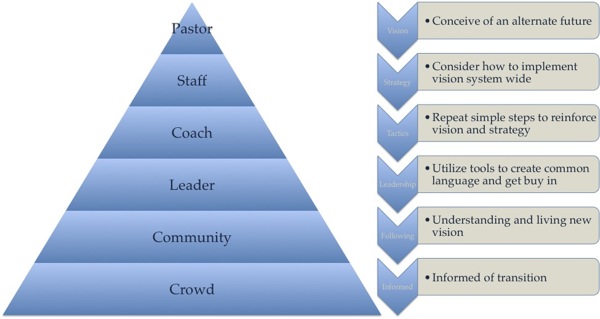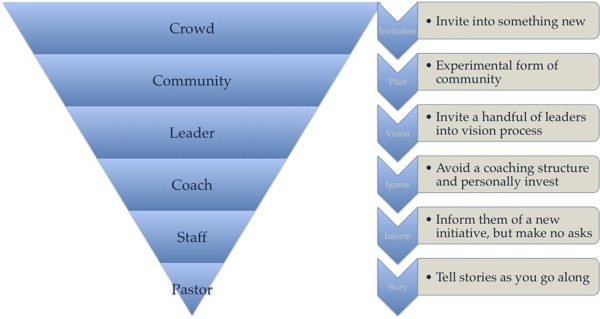The Austin Stone didn’t begin as a church committed to missional communities. Through several years, we have transitioned our church from a traditional community/small group model to our current model of missional communities. This series of posts will help you understand how we made that transition over time:
- Transitioning Your Church to Missional Communities
- Two Ways to Transition
- Creating a Sense of Urgency
- Forming a Strategic Team
- Crafting a Vision
- Communicating the Vision
- Empowering Others to Act
- Celebrating Wins
- Building on the Change
- Institutionalizing the Change
Much of this framework is adapted from John Kotter’s model for leading organizational change. I pray this series will help many of you that are leading churches through a season of transition!
—–
Two Ways to Transition
Generally speaking, if you are considering a transition to missional communities in an existing church, there are two routes you can go – top down or bottom up. Each has their own pros and cons, which I will unpack here.
The Austin Stone opted to go with the first – top down leadership. Although we utilized a lot of the principles of bottom up change, we went very quickly to reorienting our entire church around a new paradigm for ministry. Let’s start with top down driven transition.
Changing from the Top Down
Typically, most churches are structured with some amount of hierarchy. Depending on your size, you’ll have different layers represented, but generally the structure is similar. For the record, I’m not advocating right or wrong, I’m just describing what is most often the case in church organizations. Churches generally look something like the chart below:

On the left side, you see the way leadership most often works, while on the right side you see how information typically flows. Transitioning with a top down strategy means that the people at the top of the organization see a preferred future, and then begin to architect a transition for the entire structure.
Keys to Success
In order for this kind of strategy to be effective in a transition, the senior leadership must have buy in for the change. Also, a top down strategy will be very ineffective without a vision and commitment to the transition for the long haul.
Pros/Cons
The pros of transitioning this way are a larger impact on the organization, and a greater percentage of innovators inside the church being released into ministry. Quite simply, if you communicate a vision to more people, generally speaking, you’ll have more people adopt it more quickly.
The cons of transitioning this way, however, are that you will often lose people who are committed to your previous vision for ministry. Also, you may have a high number of people buy into the vision, but often their commitment is shallow and understanding of the vision is limited. Generally, when situational challenges to implementing the vision come up, many people will revert back to patterns and practices they previously used.
Changing from the Bottom Up
Transitioning from the bottom up is an alternate strategy. Generally speaking, you’re starting a new initiative at the ground level with a small number of people. Words like “pilot” and “experiment” are thrown around, and ultimately you’re hoping that the new initiative will be wildly successful and influence the ascending layers of an organization. It generally looks something like the chart below:

In the bottom up transition, you’re starting in the crowd and community, and filtering stories and vision up the communication chain.
Keys to Success
Keys to making this kind of transition work are piloting new initiatives slowly over time and keeping track of your learning along the way. If you have ambitions to influence an entire organization, it is critical to try the new strategy yourself so you have first-hand experience and can answer questions and provide stories to inspire people.
Pros/Cons
The pros of transitioning a church like this is that there is less risk of alienating people, and you have a lot of time to learn what challenges lie ahead for others who will attempt to change.
The cons of this kind of transition are that it is very slow, and often won’t change the entire organization. Because of the deliberate under-the-radar approach, it often is difficult to convince a senior leadership team of an organization of the effectiveness of the particular strategy.
What Did The Austin Stone Do?
In our transition, we spent one year in the piloting stage, but planned all along to make a major top down transition because our senior leadership was well bought in and ready for change. We certainly saw the benefits of making a major transition (lots of people tried missional communities, and great stories came from the transition), but also experienced several of the drawbacks to this approach (unnecessarily offending some people, frustrating people because we didn’t have all the answers, failing to keep pace with necessary support structures, etc)
What Should You Do?
I don’t know each of your circumstances, but in general, I would say you ought to consider the top down approach if:
- Your senior leadership team is already onboard for a transition
- The people in your church are generally flexible and willing to change
- You are convinced that missional communities are the best way to make disciples in your city
I would strongly urge you to consider a bottom up approach if:
- A senior leader is reticent or not fully vested in the change
- Your people are very committed to another model of ministry
- You are looking for a “best-practice” or a new method
The following posts will unpack our strategy for undergoing a top down transition from small groups to missional communities. What strategies have you employed to architect change?
Leave a Reply